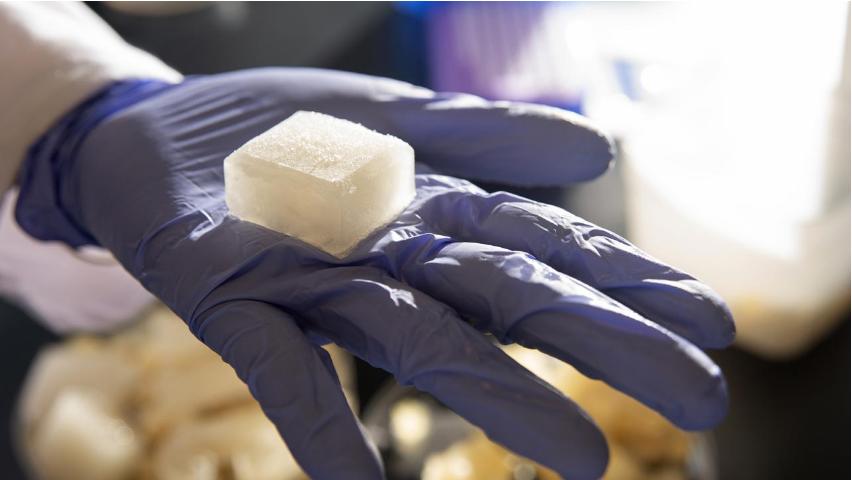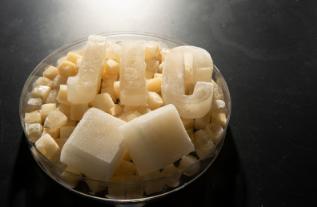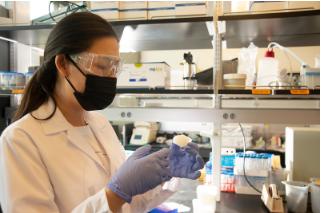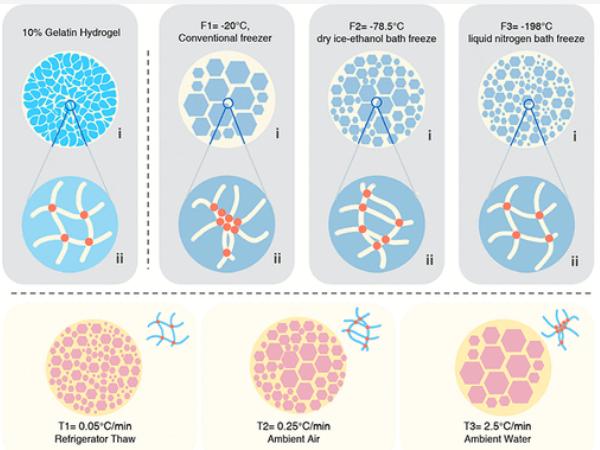博文
研究人员开发了一种不会融化也不会发霉的冰块
 精选
精选
||
研究人员开发了一种不会融化也不会发霉的冰块
诸平






据美国加州大学戴维斯分校(University of California, Davis简称UC Davis)2021年11月30日提供的消息,该校的研究人员已经开发出一种新型的冷却立方体,它可以彻底改变食物的冷藏和新鲜运输方式,而不需要依赖冰或传统的冷却袋(Researchers develop ice cube that doesn't melt or grow mold)。
这些无塑料的“果冻冰块(jelly ice cubes)”不会融化,是可堆肥和抗菌的,并防止交叉污染。加州大学戴维斯分校生物与农业工程系的孙刚(Gang Sun音译)教授说:“当冰融化时,它是不可重复利用的。我们认为我们可以制造一种所谓的固态冰作为冷却介质,并且可以重复使用。”
这种冷却立方体含有超过90%的水和其他成分,以保持和稳定结构。它们摸起来像明胶甜点一样柔软(见图1和图2),而且会根据温度改变颜色。
可重用和柔韧的冰块(Reusable and flexible)
这些可重复使用的立方体可以被设计或切割成任何需要的形状和大小,博士研究生邹嘉涵(Jiahan Zou音译)说,她(图3)在过去两年一直在从事这个项目研究。
孙刚补充说:“你可以用它冷却长达13个小时,然后对其收集,用水进行冲洗,然后将其放在冰箱里冷冻以备下次再使用。”
该设计和概念已于2021年7月份申请了专利。
研究人员希望最终利用回收的农业废料或副产品作为冷却材料。加州大学戴维斯分校食品科学与技术系副教授王璐欣(Luxin Wang,音译)说:“我们想确保这是可持续的。”
鱼市场的废水,发霉的冰块激发了灵感(Fish market wastewater, moldy ice blocks spurred idea)

研究人员开始研究这种冷却剂立方体,是因为王璐欣看到了鱼加工厂使用的冰块数量,以及融水可能在产品之间传播或流入下水道造成交叉污染。王璐欣说:“这些鱼加工场所使用的冰块量是巨大的,但我们需要控制病原体(pathogens)。”
孙刚还对学校午餐中使用的塑料冰袋和经常在包裹中发现的霉菌表示遗憾。早期的测试表明,这些立方体可以承受高达22磅的重量而不变形。只需用水或稀释漂白剂快速清洗,它们就可以重复使用十几次,然后被扔进垃圾桶或院子里的垃圾堆即可。
选择冰(Alternative to ice)
这种果冻冰块是传统冰块的一种替代品,有可能减少水的消耗和对环境的影响。它们还提供稳定的温度,以减少食品腐败,可能是理想的膳食准备公司、航运企业和需要保持物品低温的食品生产商的最佳选择。
通过控制微生物污染,该应用有可能减少食品供应链中的水消耗和食物浪费。这项研究在美国化学学会的期刊《ACS可持续化学与工程》(ACS Sustainable Chemistry & Engineering)网站上发表——Jiahan Zou, Luxin Wang, Gang Sun. Sustainable and Reusable Gelatin-Based Hydrogel "Jelly Ice Cubes" as Food Coolant. II: Ideal Freeze–Thaw Conditions. ACS Sustainable Chemistry & Engineering, 2021, 9(46): 15365–15374. DOI: 10.1021/acssuschemeng.1c06309. Publication Date: November 8, 2021. https://pubs.acs.org/doi/abs/10.1021/acssuschemeng.1c06309
上述介绍,仅供参考。欲了解更多信息,敬请注意浏览原文或者相关报道。

In an earlier study, jelly ice cubes (JICs) based on 10% gelatin hydrogels were demonstrated as a new type of food coolant. One of the practical challenges associated with the use of JICs was the structural instability against temperature variations during the phase changes of water in hydrogels, which was closely associated with freeze–thaw (FT) conditions. Here, a systematic study on various freezing and thawing rates applied to JICs was conducted to explore the ideal manufacturing and application conditions. Three freezing conditions, −20 ℃ (F1), −78.5 ℃ (F2), and −198 ℃ (F3), and three thawing rates, 0.05 ℃/min (T1), 0.25 ℃/min (T2), and 2.5 ℃/min (T3), were applied with repeated freeze–thaw cycles (FT cycles) to observe the changes of JICs in the latent heat of fusion, water content, mechanical properties, cooling efficiencies, and hydrogel inner structures. The JICs treated with the selected conditions showed significantly improved stability in water content, structural uniformity, heat-absorbing abilities, and lifecycles. With specified FT conditions, the cooling efficiency of JICs remained stable after at least 10 FT cycles. It is anticipated that both the rapid freezing rate and the slow thawing rate assist the formation of uniform polymer networks under repeated freeze–thaw cycles.
https://blog.sciencenet.cn/blog-212210-1315305.html
上一篇:研究表明,戴口罩和不戴口罩的人感染COVID - 19的风险截然不同
下一篇:研究人员将相机缩小到一粒盐的大小